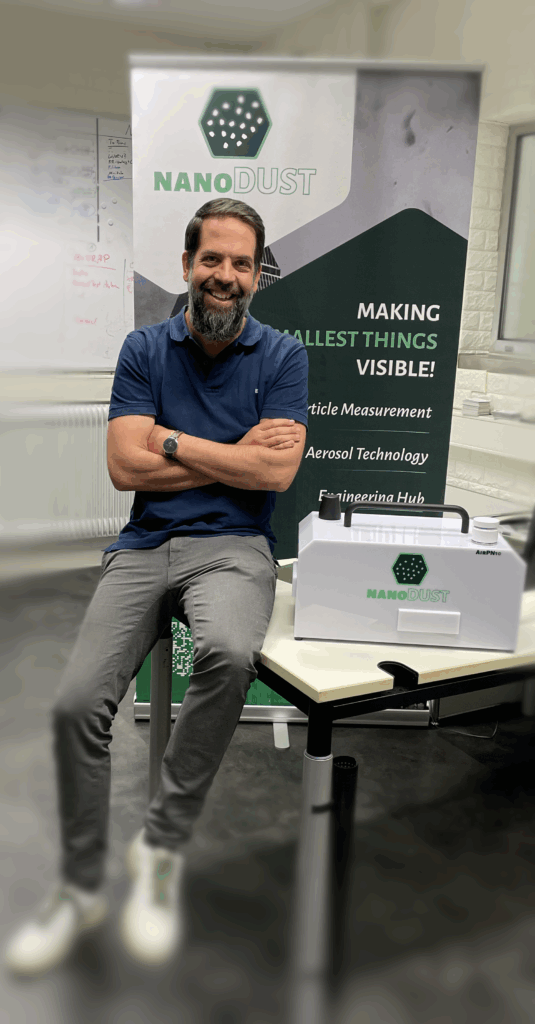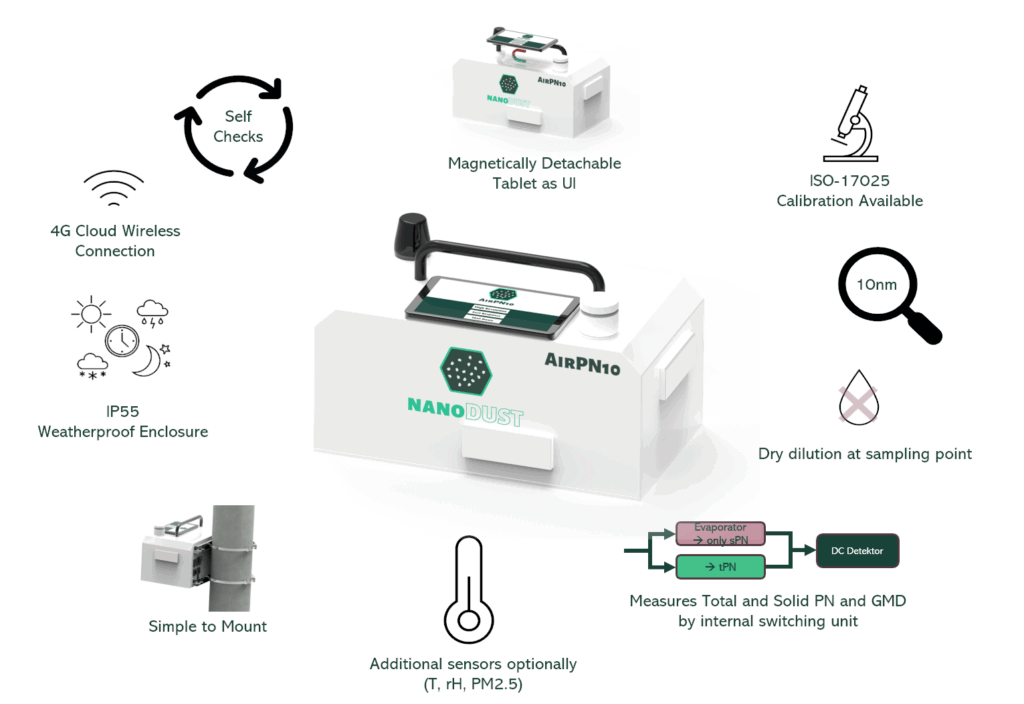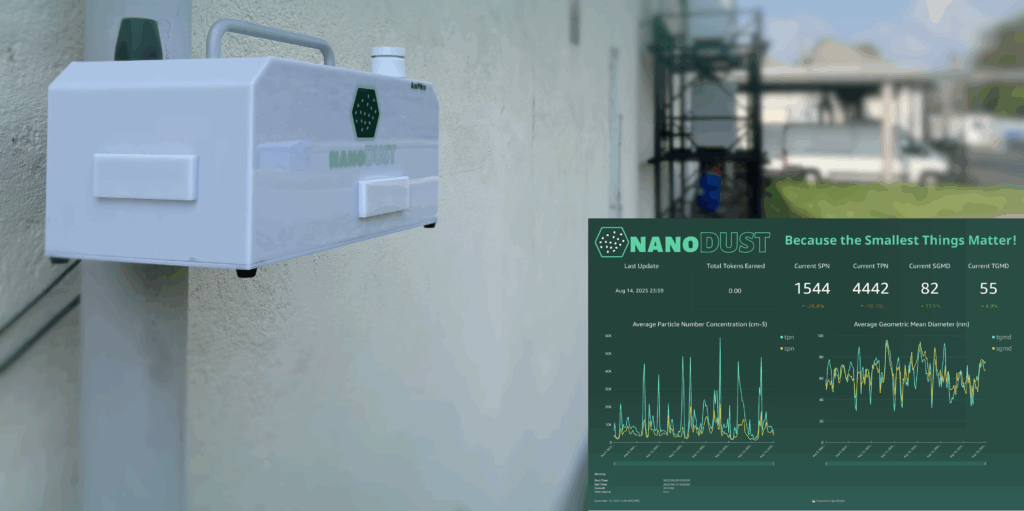15 Sep Blog |Seeing the Unseen: How nanoDUST’s AirPN10 and MI-TRAP Are Tackling Ultrafine Air Pollution
by Dr. Florian Hüwe , Founder and Managing Director of nanoDUST GmbH

The Hidden Danger in the Air We Breathe
Every breath we take contains millions of particles invisible to the naked eye. For this reason, regulators and scientists have monitored PM10 and PM2.5, two categories of particulate matter that are small enough to be inhaled and harmful to human health.
Yet there is an even smaller, more insidious pollutant hiding in plain sight: ultrafine particles (UFPs), defined as particles smaller than 100 nanometers in diameter, are about 1000 times smaller than a human hair is thick. Their size is what makes ultrafine particles so dangerous. They bypass many of the body’s natural defenses, reaching deep into the lungs, where they can pass into the bloodstream or even the brain. Studies have shown that UFPs can cause inflammation, oxidative stress, and may be linked to cardiovascular and neurological disorders.
Despite these risks, ultrafine particles are rarely monitored in cities. Traditional metrics like PM2.5 and PM10 do not capture the presence of nanoparticles in air. Even more, nanoparticles often appear more pronounced near traffic hot spots and their pollution level can vary significantly between locations even within one city. Traditional air quality monitoring systems, which focus on measuring the mass of rather large particles and in urban background locations, overlook the sheer number of UFPs in the air, especially near emission hot spots, like ports, airports, street canyons and train stations. This lack of data makes it difficult to fully assess health risks or to hold polluters accountable. It is a blind spot in our understanding of air pollution — one that urgently needs to be addressed. For this reason, the Particle Number (PN) metric becomes the new metric to shed light on pollution by small nanoparticles in the air.
MI-TRAP: Closing the Air Pollution Monitoring Gap
Recognizing this challenge, the European Union funded the MI-TRAP project (Mitigating Transport-Related Air Pollution in Europe) under Horizon Europe. Running from 2024 to 2027, the project brings together 26 partners across Europe, including research institutions, technology developers, and city authorities.
MI-TRAP’s mission is ambitious but clear: to close the gap in air quality monitoring between established air quality metrics of background stations and novel pollutants in traffic hotspots. By deploying advanced monitoring tools in ten pilot cities, the project will provide unprecedented insight into how ultrafine particles caused by traffic spread through urban environments and affect human health. Just as importantly, MI-TRAP aims to give cities and policymakers the knowledge they need to act. Data from the project will shape the next generation of air quality standards in Europe.
nanoDUST’s Role: Plug&Play Ultrafine Particle Monitoring with the AirPN10
Founded in Germany, nanoDUST GmbH is an engineering company and provider of measurement technology specializing in the detection of airborne nanoparticles and particulate matter. Our mission is to design innovative monitoring solutions for ultrafine particles — the pollutants most closely linked to adverse health effects, yet the least regulated and measured.
Within MI-TRAP, nanoDUST has taken on the task of developing the AirPN10, a groundbreaking instrument that is specifically designed for cost-effective Plug & Play monitoring of ultrafine particles near emission hotspots. Unlike traditional PM monitors, which measure the mass of micron-sized particles, the AirPN10 quantifies the nanoparticle number concentration — a far more meaningful way to understand the abundance of UFPs in the air.

The AirPN10 uses Advanced Diffusion Charging (ADC) technology established in automotive emission measurements to assess the concentrations and size of nanoparticles in air, while its Aerosol Switching Technology (AST) allows users to separate solid particles from volatile ones. This distinction is crucial because solid particles are often directly linked to traffic emissions, while volatile fractions may originate from other sources.
Developed based on the feedback from experienced researchers and environmental engineers within the MI-TRAP project, the AirPN10 was designed as a compact and user-friendly instrument. It can be deployed rapidly in the field without complex training or infrastructure. This ensures that the technology can be scaled up quickly across cities and research sites.
From Development to Application in Pilot Cities
After development. the AirPN10 has undergone rigorous type approval testing by independent metrology institute partners like METAS to validate its performance and accuracy within the MI-TRAP project. In a next step, it is currently being deployed across MI-TRAP’s ten pilot cities. Imagine, for example:
- In a busy European capital, the AirPN10 could track ultrafine particles near major traffic corridors, revealing exposure levels for pedestrians and cyclists.
- In a smaller pilot city, it might be used to evaluate the effectiveness of low-emission zones or new public transport policies.
- In cities with high volumes of shipping or aviation traffic, the instrument could provide new insights into the role of these sectors in local air quality.
By integrating data from diverse settings, MI-TRAP will create a comprehensive picture of how transport emissions contribute to ultrafine particle exposure across Europe.

Why This Matters Beyond MI-TRAP
The implications of this collaboration go far beyond the project itself. For cities, having access to reliable UFP data means being able to identify pollution hotspots and design more targeted mitigation measures. For researchers, it opens the door to new studies linking ultrafine exposure to health outcomes, potentially strengthening the evidence base for global public health policy. And for policymakers, it provides the scientific foundation needed to expand air quality regulations to include particle number standards.
nanoDUST’s work also contributes to the broader scientific community by demonstrating that high-quality ultrafine monitoring can be made both accessible and scalable. The AirPN10 proves that advanced monitoring of novel pollutants doesn’t have to be confined to laboratories or high-end measurement stations — it can be deployed in real-world conditions, providing data that truly reflects the air people breathe every day.
Personal Reflections on Collaboration
From our perspective at nanoDUST, participating in MI-TRAP is not only about technology development, but also about being part of a wider movement. Too often, environmental research remains isolated: scientists measure, policymakers regulate, and cities try to implement solutions with limited resources. MI-TRAP breaks this cycle by bringing together all the key players in a shared effort.
Developing the AirPN10 within this framework has been an inspiring process. Seeing the AirPN10 move from concept to calibration and into European cities is a reminder of why we started nanoDUST: to create tools that make the invisible visible and empower people to act.
Looking Ahead
We are curious to see how the generated data will not only generate scientific knowledge but also influence urban planning and European air quality policy. The success of the AirPN10 within MI-TRAP could serve as a model for future monitoring networks worldwide. After all, the challenge of ultrafine particles is not unique to Europe; it is a global issue. By developing solutions in Europe, we hope to contribute to healthier air and longer lives everywhere.
A next step is to integrate our AirPN10 into a blockchain-based, decentralized physical instrastructure (DePIN), designed to ensure that air quality data remains transparent, tamper-proof, and verifiable. This combination of cutting-edge hardware with secure digital infrastructure represents the next step in making environmental monitoring both credible and accessible at scale. It could empower people and investors to build up a denser monitoring network while keeping the trust in environmental data to empower citizens, researchers, and policymakers with information they can rely on.
At nanoDUST, our belief remains simple: you cannot manage what you cannot measure. Thanks to MI-TRAP and the AirPN10, Europe is finally beginning to measure what matters most — and ensuring that this data can be trusted. Together, these efforts mark a crucial step toward a cleaner, healthier future.
About the author
Dr. Florian Hüwe is the founder and Managing Director of nanoDUST GmbH, specializing in ultrafine particle measurement and sensor technology. With a PhD in physics and experience across academia and industry, he now leads nanoDUST’s mission of developing innovative measurement systems and engineering solutions: Because the Smallest Things Matter!
For more information visit: nanodust.de


